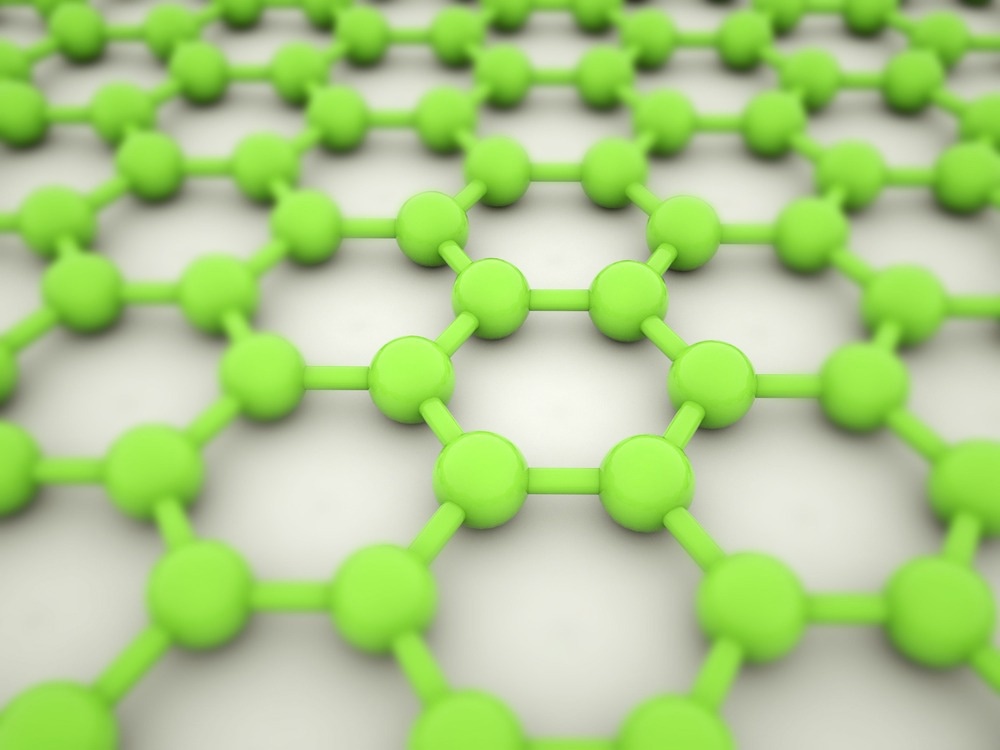Graphene quantum dots (GQDs) are a part of the carbon quantum dots family.1 These zero-dimensional carbon nanomaterials possess many superior properties, such as low biological toxicity, nanoscale size, stronger photoluminescence (PL), and electrical, and optical properties. GQDs are applied in varied fields of science and technology that include drug delivery, sensors, photodynamic therapy, and solar cells.

Image Credit: High level specialist/Shutterstock.com
What are Graphene Quantum Dots?
GQDs are tiny nanomaterials derived from graphene, a one-atom-thick, two-dimensional (2D) crystalline structure. Structurally, GQDs exhibit the same crystalline structure as graphene. This semiconductor nanomaterial comprises one or a few layers of graphene sheets whose lateral dimension is less than 10 mm. GQDs predominantly contain functional groups like hydrogen and oxygen and can bind with multiple aromatic biomolecules via π–π stacking interaction or electrostatic binding.2
What are the Properties of Graphene Quantum Dots?
GQD-based materials have recently become very attractive due to their unique physical, chemical, and biological properties. The fundamental properties of the GQDs are dependent on size, shape, and edge structure. These morphological features also play a crucial role in the position of the absorption peak. Other important factors that influence GQD properties are functional groups, reaction temperature, and solvency.3 Some of the key properties of GQDs are discussed below:
Photoluminescence
Optical properties of GQDs have been explored based on PL spectroscopy and their absorption in the visible and ultraviolet (UV) regions. These carbon nanoparticles exhibit unique absorption and luminescence properties. GQDs express a strong absorption peak in the UV region that originates from π–π* transition, and a small peak at a higher wavelength attributing to n–π* transition.4
Different colored PL is emitted by GQDs, which is dependent on the size, functional groups, layered structure, and synthesis method. The bandgap of GQDs can alter PL, i.e., an increase in bandgap is associated with decreased GQD size. In comparison to other carbon nanomaterials, such as graphene sheets, GQDs exhibit greater PL. It must be noted that the precise PL mechanism of GQDs is not fully understood. However, it has been assumed that PL is strongly related to quantum confinement and edge effects.5
Electrostatic Property
The presence of high levels of carboxyl groups that are negatively charged and conjugated π–π bonds are associated with the electrostatic properties of GQDs. Electrochemiluminescence (ECL) is a luminescence emission due to an electrochemical reaction in solution. The structural features of GQDs aid their utilization as ECL luminophores.6
Water Solubility
The presence of carboxyl and hydroxyl groups at the GQDs surface promotes their water-soluble property. The oxygen-containing functional groups help in the formation of a stable aqueous solution. However, adding specific groups on GQD’s surface can change the overall affinity of the nanomaterial. For instance, hydrophilic GQD, coupled with N, N′-dicyclohexyl carbon diimide, and subsequently reacted with epoxy ring-opening led to the transformation of hydrophilic to hydrophobic GQDs.5
Toxicity and Biocompatibility
GQD is chemically inert and exhibits excellent biocompatibility. In vitro experiments have revealed that GQDs are extremely low toxic material, which could be due to their small size and high oxygen content. In vivo experiments using mice models have shown that GQDs do not accumulate in the major organs, and are rapidly excreted through the kidneys. Even high GQD dosage did not show any significant toxic reaction.7

Image Credit: High level specialist/Shutterstock.com
What are the Applications of Graphene Quantum Dots?
GQDs possess many unique properties, which have led to a wide range of applications. Some of the important applications are described below:
Sensors
Sensors are devices that can detect and measure specific molecules in the environment. This information is converted into electronic signals that are displayed on the monitors. Since GQDs exhibit good conductivity, fluorescence, and photoluminescence, they are used as probes to detect many targets.
GQDs are used in the development of multiple sensors, such as electrochemical sensors, PL sensors, ECL sensors, glucose sensors, bioimaging, and bio-labeling.8 A GQD-based glucose sensor can rapidly detect glucose presence by assessing PL change.
The functionalized GQDs have exhibited high specificity and sensitivity in identifying small organic molecules, metal ions, and biomaterials. For instance, GQDs doped with heteroatom are used to detect nitro compounds that have harmful effects on human health and the environment.9 Nitrogen and sulfur-doped GQDs sensors are used to detect nitro explosives, such as 2,4-dinitro toluene (2,4-DNT), 1,3-dinitro benzene (1,3 DNB), 1,4-dinitro benzene (1,4-DNB), and nitrobenzene.10
Polypyrrole-GQDs sensors have also exhibited significant sensitivity in the detection of pesticides in complex media, such as seawater. GQDs/peroxydisulfate ECL sensors have been designed to detect hexavalent chromium, a toxic element.11 GQDs are used to fabricate ammonia sensors that are highly sensitive, with quick response time.
Increased hydrogen sulfide (H2S) levels have been associated with the development of cancer and Alzheimer's. In this context, a (2,4-dinitrophenoxy) tyrosine-GQDs biosensor has been designed that can detect H2S.12
Bio-Imaging
Bio-imaging helps understand biological processes at subcellular levels. GQDs, a fluorescent nanomaterial with unique optical properties, are used in bioimaging, particularly for disease diagnosis.13 A protein nanofiber (PNF)-GQDs nanohybrid has exhibited significant biocompatibility and optical properties and has been used to study cell viability and tumor cells.
Drug Delivery
Owing to their extraordinary tunable and chemical properties, GQDs are regarded as potential candidates for drug delivery systems. A Doxorubicin (DOX)/GQDs conjugate drug delivery system has been developed, which revealed significant efficacy in breast cancer treatment.
DOX is a popular drug used to treat human cancers. An accurate release of this drug into cancer cells through GQDs has improved treatment outcomes. In this context, folic acid was used as the ligand on GQDs for targeted DOX delivery to cancer cells. Furthermore, the PL property of GQDs enables real-time monitoring of drug delivery.14
Energy Storage
Recent studies have highlighted the electrochemical energy storage capacity of GQDs, making them potential candidates for electrode materials.15 These studies have also discussed that incorporating GQDs in graphene using a hydrothermal process significantly increases the performance of supercapacitors. GQDs have also been applied in the development of advanced solar cells.
Catalytic Applications
GQDs possess robust catalytic properties. They have been used as catalysts for several reactions, including electrocatalytic oxygen reduction, and water splitting, and carbon dioxide reduction. Utilization of platinum-GQDs as a catalyst exhibited significantly enhanced production of hydrogen.
Challenges in GQD Application
Although GQDs have made significant progress, there are some challenges that limit their applicability. For instance, the electrical and optical properties of this nanomaterial are dependent on the size and morphology. The current GQD synthesizing process encounters challenges in maintaining a narrow size distribution. Additionally, these methods are time-consuming and are non-eco-friendly. These challenges must be addressed to improve the application of GQD with greater efficacy.
References and Further Reading
- Kortel, M., et al. (2020). Graphene Quantum Dots as Flourishing Nanomaterials for Bio-Imaging, Therapy Development, and Micro-Supercapacitors. Micromachines, 11(9), p. 866. doi.org/10.3390/mi11090866
- Tajik, S., et al. (2020). Carbon and graphene quantum dots: a review on syntheses, characterization, biological and sensing applications for neurotransmitter determination. RSC Advances, 10(26), pp. 15406–15429. doi.org/10.1039/d0ra00799d
- Ozyurt, D., et al. (2023). Properties, synthesis, and applications of carbon dots: A review. Carbon Trends, [online] 12, p. 100276. doi.org/10.1016/j.cartre.2023.100276
- Liu, Z., et al. (2021). Size Effect of Graphene Quantum Dots on Photoluminescence. Molecules, 26(13), p. 3922. doi.org/10.3390/molecules26133922
- Cui, Y., et al. (2024). A Review of Advances in Graphene Quantum Dots: From Preparation and Modification Methods to Application. C, [online] 10(1), p. 7. doi.org/10.3390/c10010007
- Tang, X., et al. (2020). The role of electrostatic potential polarization in the translocation of graphene quantum dots across membranes. Nanoscale, 12(4), pp. 2732–2739. doi.org/10.1039/c9nr09258g
- Tabish, T.A., et al. (2018). Biocompatibility and toxicity of graphene quantum dots for potential application in photodynamic therapy. Nanomedicine, 13(15), pp. 1923–1937. doi.org/10.2217/nnm-2018-0018
- Sun, H., et al. (2013). Recent advances in graphene quantum dots for sensing. Materials Today, 16(11), pp. 433-442.
- Kumar, Y.R., et al. (2020). Graphene quantum dot based materials for sensing, bio-imaging and energy storage applications: a review. RSC Advances, 10(40), pp. 23861–23898. doi.org/10.1039/d0ra03938a
- Apak, R., et al. (2023). Selective Electrochemical Detection of Explosives with Nanomaterial Based Electrodes. Electroanalysis. 2023; 35(1), e202200175.
- Chen, Y., et al. (2015). Electrochemiluminescence sensor for hexavalent chromium based on the graphene quantum dots/peroxodisulfate system. Electrochimica Acta, 151, pp. 552-557.
- Mansuriya, B.D. & Altintas, Z. (2020). Applications of Graphene Quantum Dots in Biomedical Sensors. Sensors, 20(4), p. 1072. doi.org/10.3390/s20041072
- Younis, M.R., et al. (2020). Recent Advances on Graphene Quantum Dots for Bioimaging Applications. Frontiers in Chemistry, 8, p. 530391.
- Sawy, A.M., et al. (2023). Insights of doxorubicin loaded graphene quantum dots: Synthesis, DFT drug interactions, and cytotoxicity. Mat Sci Eng C., 122, p. 111921.
- Ansari, S.A. et al. (2022). Graphene Quantum Dots: Novel Properties and Their Applications for Energy Storage Devices. Nanomaterials, 12(21), p. 3814. doi.org/10.3390/nano12213814
Disclaimer: The views expressed here are those of the author expressed in their private capacity and do not necessarily represent the views of AZoM.com Limited T/A AZoNetwork the owner and operator of this website. This disclaimer forms part of the Terms and conditions of use of this website.